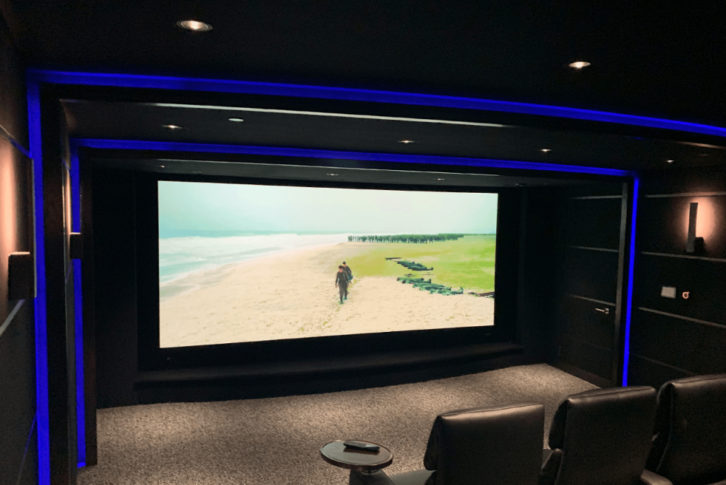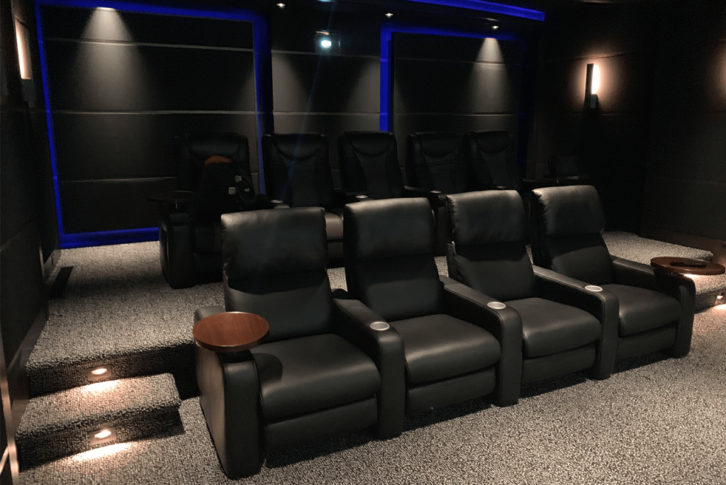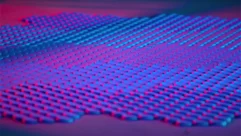 On this edition of the SVC Podcast, Contributing Editor Bennett Liles talks with Dennis Erskine, president of the Erskine Group and designer of the Reference Cinema home theater located at CEDIA headquarters in Fishers, Indiana. Dennis describes the new facility and details how it is acoustically isolated from the rest of the building that is used for offices. He also outlines the Procella Audio speaker system, the video projection and the AV control system.
On this edition of the SVC Podcast, Contributing Editor Bennett Liles talks with Dennis Erskine, president of the Erskine Group and designer of the Reference Cinema home theater located at CEDIA headquarters in Fishers, Indiana. Dennis describes the new facility and details how it is acoustically isolated from the rest of the building that is used for offices. He also outlines the Procella Audio speaker system, the video projection and the AV control system.
FOR MORE: Go to PART 2
Links:
- CEDIA Home Technology Association
- The Erskine Group, designer of high-end home cinema systems
- Procella Audio, manufacturer of advanced home cinema loudspeakers
Home theater is a huge business and it has some very innovative examples. When the new CEDIA headquarters got to the drawing board it included a top design, done by The Erskine Group. Dennis Erskine is with us today to take us through the installation of the Reference Cinema home theater at CEDIA headquarters. That’s coming up next on the SVC Podcast.
Dennis, it’s good to have you joining us on the SVC Podcast from The Erskine Group. They are to go-to guys for home theater so how about starting things off by telling us a little about your outfit, The Erskine Group and how you got to where you are now.
We’ve been around for about 20 years, and started out doing the full gamut of lighting control and audio distribution and Crestron and networks and so forth. We then backed out of that area and focused entirely on the proper design of home theaters because there was too much junk being put out there; a lot of smoke and mirrors and mythology. So we concentrated on that and became, at the time, the only company that not only did the design and engineering, but we also did the construction, the installation and the audio and video calibration. And in the last, I guess, five months we have been pushed back into the whole house engineering, designing and installation with lighting control and shades and networks and all that kind of good stuff, and Crestron. And largely because when somebody puts in a Reference theater in their home they’re now wanting to distribute those videos throughout the house, which is a network issue and a control issue and video distribution issue. So we said okay, we’ll go back to being a full-scale outfit. [Timestamp: 2:01]
And one of the biggest projects you’ve had recently was the Reference Cinema home theater at CEDIA headquarters in Fishers, Indiana, the Indianapolis area. This one’s a little more sophisticated than your average home theater system particularly in terms of acoustic isolation because it’s in the middle of CEDIA headquarters with all of the offices and other activities there. So describe the new theater for us. How does CEDIA plan to use that?
Well, the theater itself, we sound isolate all of our rooms – and I use sound “isolate” not sound “proof.” The objective in a residence is primarily that we want to have the noise floor in the room less than 22 dB because 22 dB is the softest sound that is recorded on a soundtrack. The average noise floor in a very quiet home is 30-35 dB and so we don’t want people turning up the volume by a factor of 6-8 just to be able to hear the whispers and get dialogue intelligibility. The difference with a CEDIA installation being in a commercial building with offices around is that we did have to sound proof, if you will, and we did that by building all four walls of concrete and put a concrete cap on top of it as well. And then inside the room we did what we normally do in a residence. We can do that level within a private residence but for a house that is not under construction that can be a real budget buster to go back and try and retrofit that with concrete walls and so forth. [Timestamp: 3:38]
I can imagine.
And CEDIA’s use for the room, it’s part of their Experience Center so they want to allow members to bring customers in there to see what we do, how we do it, what the possibilities are in terms of integrating all of the home systems, including the refrigerator, if you will, even with voice activation using artificial intelligence. And the theater, then, is a part of that. This is the way a theater should sound and perform from a video perspective. This is what you should be delivering to a customer. The other function of this room, which will happen later on, is that we do have home theater boot camps which is sort of an introduction to proper design in a room and calibrating the audio and video. What we want to use the Reference Theater for is we have the ability to zero out everything we’ve done and use it as an advanced training. So people can spend an advanced training course in there on audio and video calibration and we then have the ability to switch back and forth between what they did and what we did so they can hear and see the differences between what they did and what we did and use it as a learning environment to sort of upscale the knowledge base and expertise of our members in delivering these kinds of rooms. [Timestamp: 5:02]
Situated right in the middle of CEDIA headquarters. How much of a chunk of that building does the Reference Cinema home theater occupy?
Well, the total space occupied by the theater including the equipment and projection room is right around 760 square feet of a 40,000 square foot building. And so we’re using slightly less than two percent of the floor space. [Timestamp: 5:23]
OK, so that requires a lot of isolation. You’ve got to get heating and air in there, electrical and that must have been a sizable job in itself.
Well, the trick to that is in any case where you’re trying to do sound isolation at all, you do have to bring in network cables, electric and HVAC. HVAC is one of the most overlooked things in the design of any home theater. But the way we do that is since we have to penetrate the barrier, we bring those items in behind a second barrier so that we can then route the HVAC and so forth around in such a way as to reduce any sound leakage through the penetrations in the sound isolation wall. I’ll use an example because math is easier. If you have eight seats in a room, that’s 4,000 BTU’s an hour of cooling that’s required. And since these rooms are basically airtight, that’s also saying you need to bring fresh air in. So if you don’t do that then rooms become hot and stuffy, and the minute they become hot and stuffy the rooms fall into disuse. We don’t want rooms falling into disuse. They’ve invested a fair amount of money into these things and not using them is like having a Ferrari you keep in your garage all year. [Timestamp: 6:40]

Yeah, that’s for sure especially after you’ve gone to all that work you want people to come in and enjoy it. You had partnerships with AV manufacturers who came in with some of the best sound and video gear anywhere. How did CEDIA and Procella Audio come together on this and what did Procella provide?
The way the process worked, and I had to recuse myself from these efforts, is they took bids from other members on the design and delivery of the room. We were fortunate to win it. When I engineered the room I specified in that engineering Procella speakers. So when we were awarded that we and CEDIA went to the vendors that we had specified equipment and said what can you do for us? And both Procella and Trinnov, for example, said, “What do you want? We’re donating it.” [Timestamp: 7:31]
Alright. Well, that’s something that I’d be glad to hear.
Yeah, yeah. Well, it’s good for them and it’s good for us because we can show off something that’s very nice. [Timestamp: 7:39]
Yes, I’m sure that a lot of companies wanted to have their stuff in there.
Yeah. And Barco, by the way, provided the projector. There were other vendors involved, but those were the ones that people typically see and hear. [Timestamp: 7:48]
OK, that was the Loki projector from Barco?
Yeah.
And for the projection, what kind of screen did you put in there?
The screen was donated by Stewart and it was a VistaScope, In other words, we have automated side masking panels and a Microperf screen so all the speakers are where they belong behind the screen. [Timestamp: 8:07]
Yeah, with a small house and a really big screen you’ve got a very immersive environment there.
It really is. I wish I lived in Indianapolis so I could go up there at night and watch movies. [Timestamp: 8:19]
And how do they control all of this? You have I believe a Crestron control system. So what AV sources do you have available on it?
DISH Network provided us with their Hopper system. Kaleidescape provided a Strato loaded with movies for us. So we have DISH, we have Kaleidescape in there, and an OPPO Blu-ray player so we can do everything in 4K. Now throughout the building, this is something that’s worth noting, is those sources are directly connected to the theater system. But throughout the building we have small meeting rooms and group rooms to get together that have the ability for you to plug in your laptop to the local screen so you can run slide presentations or whatever. But any source in that building can be displayed on any or all video devices in the building and that’s all done through Crestron MVX. And our theater is also controlled by Crestron. [Timestamp: 9:22]
Completely unified system which is a great idea since the theater is only two percent of the building and you have a lot of other things going on there. You have bi-amplified Procella P815 speakers. Is that an 11.4.8 channel system?
Well, that’s not quite right. [Laughs] If you physically count the speakers it’s 11.4.8. But the interesting thing is that it’s really not four subwoofers. We have four physical subwoofers each with two 18-inch drivers and we treat each of those drivers as an independent channel. So really we have eight subwoofers although they’re physically located in the same cabinet. [Timestamp: 12:38]
Those are the Procella P18 subwoofers you’re referring to?
Yeah. They’re the P18 subwoofers.
Well, I can imagine that once you get all of that cranked up and you’re in the middle of it, it would be easy to just forget where you are and get totally immersed in the presentation.
Yeah, and since you can’t hear anything going on in the building the presentation is right there. We did some testing and we were able to get to 130 dB with no audible distortion and you couldn’t hear it outside the room. [Timestamp: 10:36]
You’re people brought no shortage of experience on home theater into this so when you knew that you were going to have this project, were there other facilities that you’ve done before that sort of served as a guide or that you took ideas from for this one?
No, not really. It’s a culmination of our 20 years of experience of doing this, learning from past experience. The interior design, they said they wanted it to be contemporary so we did that. I don’t want to say it’s completely unique from anything else we’ve done, but there are similarities in terms of the interior design of the room. But there’s a lot of things that come into play in this right down to the way we circuit the lights in the room. Some examples are we don’t put sconces on columns. Who wants to knock their head into a sconce that’s sticking out from what’s sticking out already? And they’re circuited in such a way that if you want to have some light in the room there are no lights that come on that are in front of the eyes, so they’re not a light beam that you focus on. Lutron, by the way, provided Ketra lighting for that room so we’re able to change the color temperature in the room for any number of reasons. [Timestamp: 11:43]
Big project and a very prestigious one in CEDIA headquarters. You don’t get any bigger profile home theater project than that. It was probably easier dealing with the real pros than the sometimes offbeat ideas from private homeowners. In Part 2 we’ll get into the Experience Center, go step by step on the installation and the testing and calibration. Been good having you here with us. It’s Dennis Erskine from the Erskine Group of home theater experts and the Reference Cinema home theater at CEDIA headquarters. See you then, Dennis.
All right. Thank you.
CEDIA headquarters now has the smart-home Experience Center and the Reference Cinema home theater for clients to use and to wow all the visitors. Only fitting that the design by The Erskine Group is second to none. Next week Dennis will be back to take us through the steps of installation on the new theater right here on the SVC Podcast.










